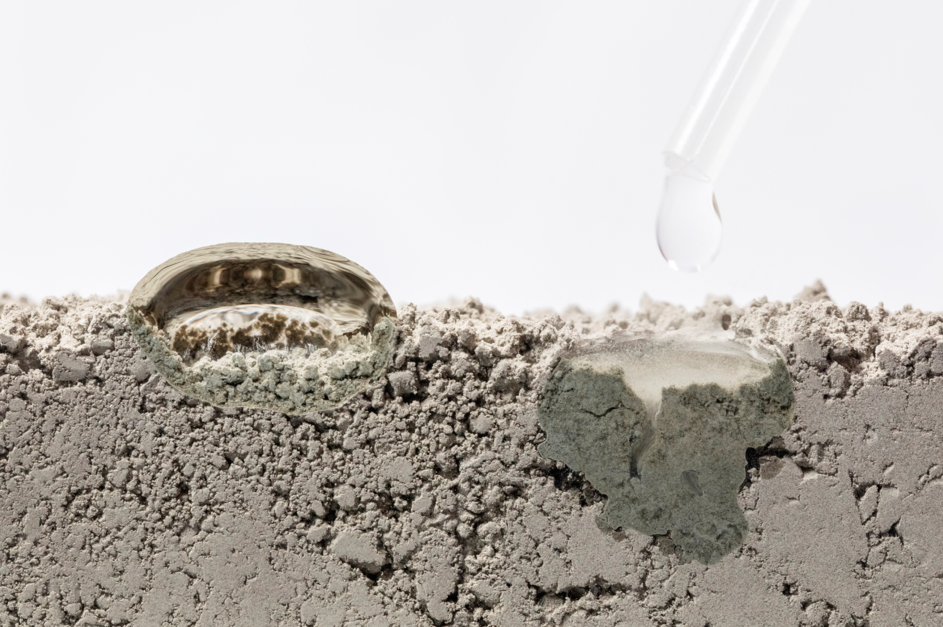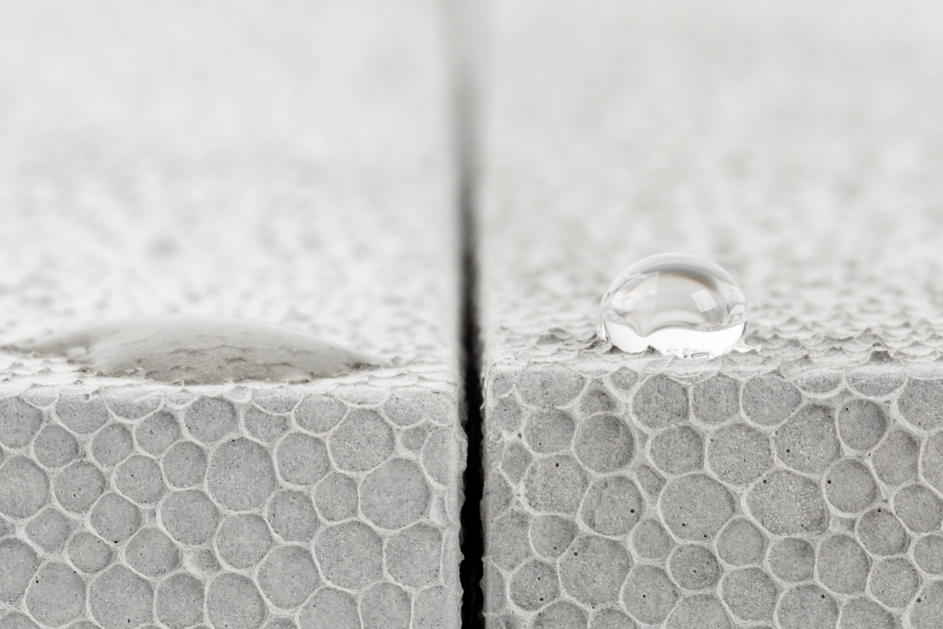COMBATING CRUMBLING CONCRETE
Concrete was already being used in Roman times to erect buildings that would last almost for eternity. So it is all the more astonishing that some of today’s concrete structures reveal serious damage after only a few years. One reason is the alkali-silica reaction (ASR). WACKER’s building-protection experts are taking steps to stop ASR by subjecting the concrete to integral treatment.
A naturally occurring chemical reaction is silently destroying concrete structures such as road surfaces, bridges and tunnels. At first, the ASR problem is invisible and does not get noticed for some time. Initially, harmless-looking, superficial cracks reveal themselves. Later, larger fragments flake off and the concrete gradually begins to crumble. Damaged concrete structures such as highways and runways need to be repaired after only a few years in some cases.
Concrete is an artificial mineral construction material obtained by mixing together water, cement (as binder) and coarse gravel or slag and/or sand (as aggregate). The Romans called concrete opus caementicium and used it to build the huge dome of the Pantheon, which has been a source of wonder in Rome for nearly 2,000 years. They managed to make their concrete so incredibly strong by using high-quality aggregate, to which they added volcanic ash.
TOP-QUALITY SAND NEEDED
Some concrete structures survive undamaged for a very long time indeed, for millennia in the case of the Pantheon. By contrast, it takes only a few years before buildings in which inferior-quality sand, for example, was used suffer from ASR. In some regions of the world, the construction industry commonly refers to this destructive reaction as concrete cancer as it can develop over time while showing no visible signs or symptoms.
“In particular, what determines whether a building is prone to ASR is the aggregate – in other words, the material that is mixed with water and cement to make concrete,” explains Dr. Wei Cai, a materials scientist and member of WACKER SILICONES’ Construction Chemicals team in Burghausen. “If the aggregate contains a high amount of alkali-reactive siliceous components, they can combine, in the presence of moisture, with the alkali and hydroxide ions of the pore solution in the concrete to form a swellable alkali silica gel.” In this particular context, swellable means that the volume expands on contact with water, exerting a pressure inside the microstructure that may cause the destructive cracks, efflorescence and spalling in the concrete associated with ASR.
There are only a few ways to minimize the ASR risk. For example, you can reduce the amount of alkali in cement or from external sources and the amount of reactive silica in the aggregates. The actual amount that can be reduced depends primarily on the kinds of raw materials available in a particular region and on their mineral composition. And in some parts of the world, raw materials like sand and gravel, especially high-quality grades, are becoming scarce. That is why inferior grades are often used to mix concrete, which can dramatically reduce the strength of the cured material.
Alternatively, you can add soluble lithium compounds during concrete production – thereby eliminating the detrimental effects of ASR. While we don’t fully understand the chemical forces at play here, experts assume that lithium bonds better with silicates – and the resultant gel is not prone to swelling. This approach is very expensive, however, because naturally occurring lithium salts and minerals are in high demand for electric-car batteries, which has increased prices, too.
In contrast, WACKER has taken a different tack, as Dr. Cai explains: “ASR needs water. We can deprive concrete of this water by treating it with silicone resins during production.” The silicone and silanes have been acting as water repellents for years. They are brushed on during the subsequent surface treatment of concrete and other cementitious systems. When used as additives in concrete and cement production, these silicones introduce their impressive water-repellency from the very start. “What is known as integral treatment involves the incorporation of silicone resins into the still liquid mixture of fresh concrete. The sections of concrete undergo bulk impregnation,” he explains.
WATER VAPOR CAN PASS THROUGH
Whereas water wets conventional concrete very easily, tiny droplets form on water-repellent concrete. “Our scanning electron micrographs were able to capture this phenomenon,” added Cai, who is an industry manager at the Construction Silicones unit. “Silicones form a thin film along the tiny pores and increase the overall resistance of the concrete to the harmful alkali-silica reaction.” At the same time, water vapor can continue to pass through the layer of silicone, which means that the concrete is still breathable.
What’s more, the silicones counteract other phenomena that damage concrete and which rely on the presence of moisture – such as efflorescence. This is defined as the formation of mineral coatings on artificial or natural stone. In the case of concrete, efflorescence manifests itself as an unattractive calcium carbonate haze, which usually, however, only affects the appearance rather than the functionality of the material.
Another process that requires water as a carrier is the chloride-induced corrosion of reinforcing steel in concrete, which occurs when road salt penetrates into it. It’s a similar story with carbonation: CO2 reacts with cement to form limestone on contact with water. The pH drops and the reinforced concrete may be affected, too. Since silicones keep water at bay and so eliminate, or at least reduce, all these reactions, they afford multiple types of protection all at once. In addition, their barrier is environmentally compatible and long-lasting, as silicones can’t leach out and do not pose any risks whatsoever to people or the environment.
“Our silicones form a stable chemical bond with the minerals in the concrete. Their hydrophobic components stick out from the surface like tiny umbrellas and keep moisture off,” Cai explains. “This network is very robust and protects the concrete from the inside out, so to speak, against a variety of weathering effects.”
SUCCESSFUL TEST RUNS
The silicones and silanes have already passed their initial test runs at the VDZ (Association of German Cement Manufacturers). These tests involve exposing a section of concrete to varying concentrations of salt solution. “We used aggregates that run a high ASR risk. Just low amounts of our products, which are between 0.2 and 0.5 percent by weight of cement, were enough to greatly impede the destructive alkali-silica reaction,” he said. One major advantage is that the silicones can be used regardless of the starting mineral involved, making them suitable for all concrete raw materials. In this way, use can be made, too, of regionally available aggregates and grades of sand whose mineral composition may make them more susceptible to ASR. The use of such materials is gaining in importance worldwide across the construction sector. This is because aggregates – such as high-quality sand and ballast needed to build roads, tunnels and bridges – are becoming increasingly scarce. Another benefit that concrete manufacturers, in particular, will reap is that the silicones and silanes are very easy to handle and offer absolutely straightforward metering during production.
“Sustainability trends are making themselves increasingly felt in the construction industry,” explains Dr. Rudolf Hager, who heads the Construction Chemicals business team at WACKER SILICONES: “The following factors all play an increasingly key role: the durability of buildings, the energy-efficient provision of materials, short and hence environmentally sound transport routes, and the conservation of ever scarcer raw materials such as sand. We are using our silicones to tackle these very topics.”
It’s just one aspect to lower the ASR risk and so prolong the service life of highways. Using silicones as an additive in cement production, for instance, has had a positive effect as well: they reduce consumption of electricity, thereby helping to cut carbon dioxide emissions. At the same time, silicones ensure that the cement agglutinates less, thus extending its storage stability. The more intensively Dr. Cai and his WACKER colleagues examine the supply and technology chain of concrete, the greater the number of applications opening up for silicones. These experts all play a part in making construction activities more sustainable going forward.


